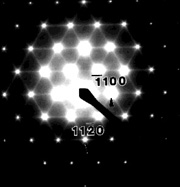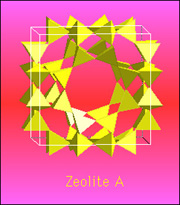

Our programme of work on the Rigid Unit Mode (RUM) model has developed from the simple observation that the forces operating within the SiO4 and AlO4 structural units in crystalline silicates are much stronger than any other forces in the structure, including the flexing of the Si-O-Si bond angle. As a result, when there is a displacive phase transition in a silicate, the structure deforms by rotations and translations of these tetrahedra without the tetrahedra being directly forced to distort.
Although this observation is hardly new, what we have been able to do is to develop some predictive power. Our starting point was to think about any general deformation of the crystal structure as a phonon mode, and then to address the issue of calculating all phonon modes that propagate without the tetrahedra needing to distort - these we call the "Rigid Unit Modes" (RUMs). We have developed a molecular lattice dynamics approach to solve this problem, and the resultant program, called CRUSH, can be used to calculate the number of RUMs for any given wave vector. This program is available to anyone who wants to try to run it, and advice can be obtained by email.

We have taken this model further by taking account of the finite stiffness of the SiO4 and AlO4 tetrahedra, and also the forces that operate between the tetrahedra, but still keeping the resultant theoretical models in the framework of rigid units. This has allowed us to explore some of the energetic and dynamic aspects of the model.
The RUM model has been developed for a wide range of applications, some of which we are still pursuing:

See also our main RUMS page.
Some papers...
K D Hammonds, H Deng, V Heine and M T Dove, "How floppy modes give rise to adsorption sites in zeolites". Physical Review Letters (submitted)
This paper reports the application of our RUM model to zeolites, focussing on the way in which linear combinations of static RUM distortions can lead to the formation of local deformations of the zeolite cages.
M T Dove, "Silicates and soft modes". In Amorphous Insulators and Semiconductors: Proceedings of NATO ASI, ed. Thorpe, M.F. and Mitkova, M.I. (Kluwer, Dordrecht, in press)
Here I describe the RUM model in a review format.
M T Dove, "The theory of displacive phase transitions: A review". American Mineralogist (in press)
The title says it all - lots of equations relevant to the soft-mode model, reviewed in the context of phase transitions in minerals.
K D Hammonds, V Heine and M T Dove, "Insights into zeolite behaviour from the rigid unit mode model". Phase Transitions (in press)
From the same workshop, this is a summary of the work that was later developed into the paper submitted to Physical Review Letters, focussing on the way in which the local distortions of zeolite cages can arise from linear combinations of static RUM distortions.
A K A Pryde, K D Hammonds, M T Dove, V Heine, J D Gale and M C Warren, "Rigid units and the negative thermal expansion in ZrW2O8". Phase Transitions (in press)
From the same workshop, this is a summary of our work on ZrW2O8.
M Gambhir, V Heine and M T Dove, "A one-parameter model of a rigid-unit structure". Phase Transitions (in press)
From the same workshop, this is a description of the application of a simple pair potential model to study the dynamics of the cubic phase of cristobalite.
M T Dove, M J Harris, A C Hannon, J M Parker, I P Swainson and M Gambhir, "Floppy modes in crystalline and amorphous silicates". Physical Review Letters (in press, LV5958, 21/8/96)
This is mostly experimental, measuring the low-energy vibrational spectra, but our pair potential models were used to interpret the results.
A K A Pryde, K D Hammonds, M T Dove, V Heine, J D Gale and M C Warren, "Origin of the negative thermal expansion in ZrW2O8 and ZrV2O7". Journal of Physics: Condensed Matter 8, 10973-10982, 1996.
Our Rigid Unit Mode model was applied to try and understand the origin of the negative thermal expansion in these ceramics. Model pair potentials were developed and used to calculate the negative thermal expansion coefficient.
K D Hammonds, M T Dove, A P Giddy, V Heine and B Winkler, "Rigid unit phonon modes and structural phase transitions in framework silicates". American Mineralogist 81, 1057-1079, 1996.
This is our large study of the rigid unit modes in a range of aluminosilicate minerals.
M T Dove and M J Harris, "New light on the dynamics of silicate glasses". in ISIS 96, The ISIS Facility Annual Report 1995-96, pp 48-49, 1996.
This is mostly experimental, measuring the low-energy vibrational spectra, and is a simple version of our Physical Review Letter, but the pictures of the calculations were nicely drawn by a graphics artist.
M T Dove, M Gambhir, K D Hammonds, V Heine and A K A Pryde, "Distortions of framework structures". Phase Transitions 58, 121-143, 1996.
A review of our RUM work, slanted towards the formation of static deformations. This was from a workshop on perovskites.
M T Dove, V Heine and K D Hammonds, "Rigid unit modes in framework silicates", Mineralogical Magazine 59, 629-639, 1995.
A review of our RUM work, with our first ideas on what drives displacive phase transitions.
M T Dove, K D Hammonds, V Heine, R L Withers, Y Xiao and R J Kirkpatrick, "Rigid unit modes in the high-temperature phase of SiO2 tridymite: calculations and electron diffraction". Physics and Chemistry of Minerals 23, 55-61, 1996.
Observation of curved surfaces of RUMs, with supporting calculations.
I P Swainson and M T Dove, "Molecular dynamics simulation of alpha- and beta-cristobalite". Journal of Physics: Condensed Matter 7, 1771-1788, 1995.
Molecular dynamics simulation of the two phase of cristobalite using pair potentials. The results showed that the high-temperature phase is dynamically disordered.
K D Hammonds, M T Dove, A P Giddy and V Heine, "CRUSH: A FORTRAN program for the analysis of the rigid unit mode spectrum of a framework structure". American Mineralogist 79, 1207-1209, 1994.
Description of our basic computer programs for the determination of the RUMs in any structure.
I P Swainson and M T Dove, "Comment on 'First-Principles Studies on Structural Properties of beta-cristobalite'". Physical Review Letters 71, 3610, 1993.
A comment on someone else's paper, in which we point out the possible role of RUMs.
P Sollich, V Heine and M T Dove, "The Ginzburg interval in soft mode phase transitions: Consequences of the Rigid Unit Mode picture". Journal of Physics: Condensed Matter 6, 3171-3196, 1994.
A theoretical study of the role of RUMs in determining critical behaviour, supported by molecular dynamics simulations.
M T Dove, A P Giddy and V Heine, "On the application of mean-field and Landau theory to displacive phase transitions". Ferroelectrics 136, 33-49, 1992.
A theoretical study of the application of the RUM model to displacive phase transitions.
I P Swainson and M T Dove, "Low-frequency floppy modes in beta-cristobalite". Physical Review Letters 71, 193-196, 1993.
Molecular dynamics simulations support the general idea of the importance of RUMs in determining the nature of the high-temperature phase of cristobalite.
M T Dove, A P Giddy and V Heine, "Rigid unit mode model of displacive phase transitions in framework silicates". Transactions of the American Crystallographic Association 27, 65-74, 1993.
Our first submitted paper on the RUM model.
A P Giddy, M T Dove, G S Pawley and V Heine, "The determination of rigid unit modes as potential soft modes for displacive phase transitions in framework crystal structures". Acta Crystallographica A49, 697-703, 1993.
The nuts and bolts of our simulation methods used in our RUM model.
F S Tautz, V Heine, M T Dove and X Chen, "Rigid unit modes in the molecular dynamics simulation of quartz and the incommensurate phase transition", Physics and Chemistry of Minerals 18, 326-336, 1991.
Large-scale molecular dynamics simulations were used to study the incommensurate phase transition in quartz in terms the role of Vallade's rigid unit modes.
Link back to ...
Page on the phase transition in cristobalite